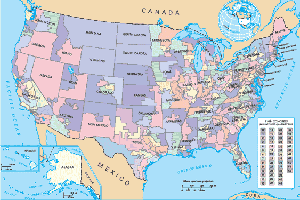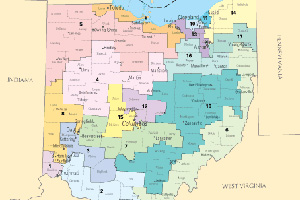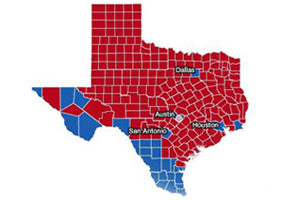
<a href="http://www.nationalatlas.gov/printable/congress.html">nationalatlas.gov</a>.
Not a fan of your new GOP-dominated House of Representatives? You’d better get used to it. After winning almost unprecedented power over the congressional redistricting process, Republicans are poised to lock in their gains for a decade or more. And there’s very little the Democrats can do to stop them. This year, the Dems could draw less than half the districts the GOP does.
The Republican wave couldn’t have come at a worse time for Dems. America’s once-a-decade census has wrapped up, and many states are due to change the boundaries of their congressional districts. Population-based adjustments mean that slower-growing states (like Ohio) will lose seats, while faster-growing states (like Florida) will gain them. [More on that here: Secrets of the Census.]
But even those states that don’t gain or lose seats will have a chance to redraw their congressional districts. By carefully drawing boundaries to include or exclude Dem or GOP-leaning communities, redistrictors can all but determine the outcome of House elections in advance. And most of those redistrictors are going to be Republican.
Here’s why. GOP victories in Tuesday’s midterms weren’t limited to House and Senate races. Across the country, voters elected new Republican governors and more than 650 new state legislators. In most states, winning the “trifecta”—the governorship and both chambers of the state legislature—gives a party full control over district-drawing. Republicans have achieved that holy grail of redistricting in 14 states: Alabama, Florida, Georgia, Indiana, Kansas, Michigan, Ohio, Oklahoma, Pennsylvania, South Carolina, Tennessee, Texas, Utah, and Wisconsin. (They’ll also control the process in New Hampshire and North Carolina, where they control both chambers and the governor plays no role in redistricting.) [More on the trifecta here: The Real Prize in Tuesday’s Elections.] The GOP hasn’t controlled this many state legislatures since 1928.
Not all congressional districts will be drawn by Democrats or Republicans. Seven states are single-district states: there will be no boundaries to draw there. Another eight states have turned most of the work of redistricting over to an independent commission. (California recently joined this group.) Nebraska has a unicameral, nonpartisan legislature, so it doesn’t count. In another eight states, neither party will have full control over redistricting. In those states, compromise (and incumbent-protection maps) will be the name of the game. And in Colorado, Rhode Island, and New York, it’s still unclear who will control the process.
After you remove all of those exceptions, Republicans will still have unobstructed power to draw the boundaries of 164 congressional districts—nearly 30 percent more than they drew last time around. The Democrats, by contrast, will draw between 47 and 88 congressional districts. As of November 5, President Obama’s party is only certain to control the process in six states: Arkansas, Connecticut, Massachusetts, Maryland, West Virginia, and Illinois. That’s just 47 congressional districts—113 fewer than the Republicans are certain to draw.
If Dems hold the Colorado House (and Dems are cautiously optimistic about that) and can work with Rhode Island’s ex-Republican Governor-Elect Lincoln Chafee, they’ll get to draw nine more districts. The party’s prospects for controlling the process in New York (which will have 27 seats in 2011) and Oregon (which will have 5) are significantly dimmer. Both those states are likely to have split control. But even in the Dems’ unlikely best-case scenario, they’ll draw 13 fewer districts than they did in 2001. And if things really don’t go their way, they’ll draw fewer than half the districts they drew 10 years ago.
It’s actually even worse for Dems than that. Two just-passed amendments to Florida’s state constitution will, at least in theory, require the Republican trifecta there to draw districts that are compact and fair. But the Republicans still get to do the drawing, and the amendments are being challenged in federal court. (Dems are optimistic that the court challenges will fail, but nothing is certain.) Still, even a small improvement in the Florida map could help Obama’s party. The current map is the “most effective Republican gerrymander in the country,” says Carolyn Fiddler, a spokeswoman for the Democratic Legislative Campaign Committee, which helps Dems in state legislative races.
On the other side of the country, California, with its new Democratic governor, overwhelmingly Dem legislature, and 53 congressional districts would have represented a significant redistricting opportunity for the Dems. But the Golden State just became the latest to take redistricting out of the hands of legislators and give it to a nonpartisan commission. That change more than doubled the number of districts nationwide that are drawn by commission—from 35 before California’s addition to 88 after it. It also represents a form of unilateral disarmament on the part of Dems. Even without California, the majority of congressional districts that are drawn by commissions are in blue states.
“Most Democrats, myself included, agree with the objectives of these reforms,” says Tom Bonier, a redistricting expert at the National Committee for an Effective Congress, which helps progressives with redistricting strategy. “But when applied only in Democratic states it becomes a problem.”
Some Democrats hope that legal challenges to GOP gerrymanders will bear fruit. They even have an organization, the Redistricting Trust, set up to fund such court fights. But success is somewhat unlikely. Last time around, Dems challenged the maps in Texas, Michigan, and Pennsylvania. They lost all three. “Frankly,” says Bonier, “there’s very little basis for taking partisan gerrymandering claims to court.”
There is one last hope for the Democrats, however: pulling a Tom DeLay. In 2003, angered by what he saw as an unfair Dem gerrymander of Texas, the former Republican House majority leader launched an unprecedented mid-decade redistricting effort and forced at least four Texas Dems out of their seats in the next election. Over the course of the past decade, the Democrats had the opportunity to do something similar in Nevada, New Hampshire, New Mexico, New York, Oregon, and Wisconsin. They never did, and those chances are gone. “Unfortunately,” says Bonier, “no one has a time machine to go back and do that.” But he says future mid-decade redistricting is something Dems could “consider.”
The problem with the DeLay strategy, however, is that state legislators don’t just draw congressional districts: Often, they draw their own, too. So the Republican state legislative gains this year will be enormously self-reinforcing. It could take a major political failure—another George W. Bush, or something similar—to upend the GOP’s current dominance.
If redistricting presents any problems for Republicans, it will be that, in some states, they won too many House seats. In Ohio, which is due to lose two seats in redistricting, Republicans now control all but five of the state’s 18 seats. It will be very hard for Republicans to draw Ohio’s Dems into fewer than four seats, so they may need to jettison one of their incumbents. But these are problems that political parties want to have. Bonier says he expects that the GOP will focus on trying to lock in its gains for years to come, but also take opportunities “where they see them” to add to their majorities. Fiddler agrees. “I think we have reason to believe that Republicans will milk it for all it’s worth,” she says.














